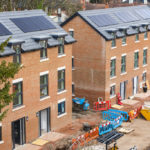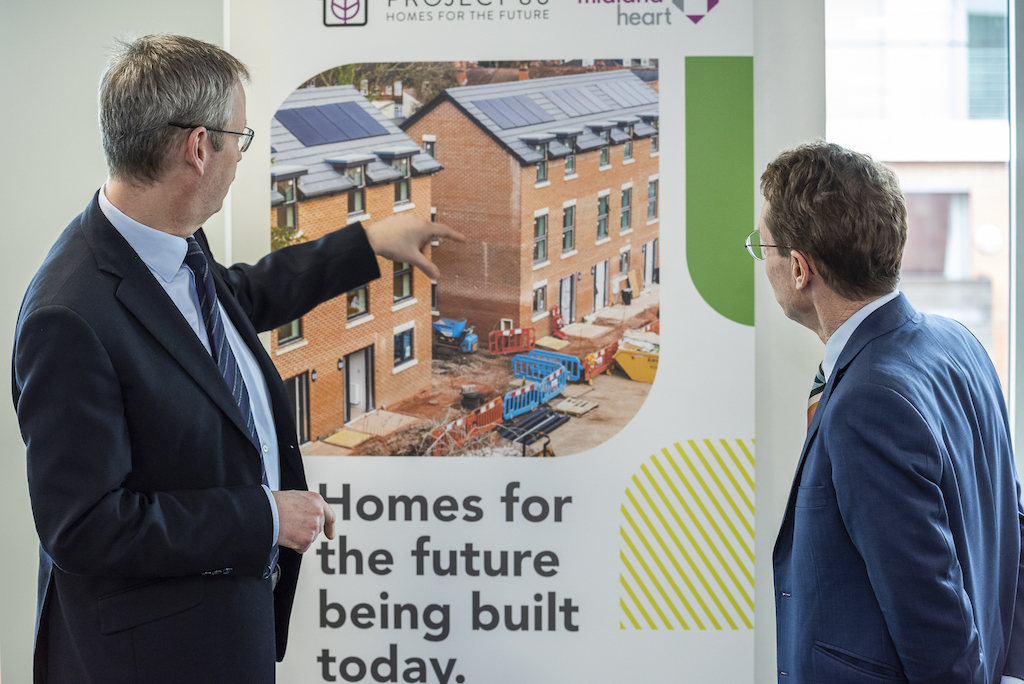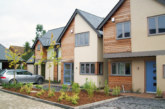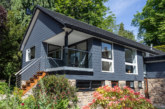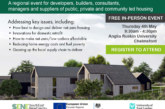Jenny Smith-Andrews, Head of Marketing at H+H, discusses Project 80, a sustainable housing project that is building for the Future Homes Standard, three years early.
The Future Homes Standard (FHS) is coming into effect in 2025. It will require a 75-80% reduction in the carbon emissions buildings produce over current standards. But how will this actually affect the construction of normal homes? Project 80 is planning to find out.
The project is an industry-first collaboration led by Midland Heart Housing Association with Tricas Construction, Birmingham City University and UK suppliers, including H+H. They plan to build 80 homes that meet or exceed the 2025 FHS, with the first 12 masonry homes now complete.
The aim of the project was to design standard housing using locally sourced materials and labour and compare the performance of different methods, materials and technologies to see which produce the best results at what cost.
Energy efficiency standards required by FHS are met by a combination of high fabric efficiency and low carbon heating. The technologies that are being trialled include air source heat pumps, solar panels, MVHR and more.
Birmingham City University are conducting in-depth research, monitoring every step of the construction process and will conduct post-occupancy research to understand how the homes perform once residents move in.
The ultimate goal of Project 80 is to pave the way for the FHS before it begins by generating rigorous empirical evidence to support the scalable construction of sustainable homes.

Masonry leading the charge
With the government’s target of 300,000 new homes per year by the mid-2020s, and the need for them to be decarbonised and ‘future proofed’ to meet the FHS, understanding how best to construct these homes is imperative.
This was part of the reason brick and block masonry construction was chosen for Project 80’s first phase over MMC alternatives. Opting to test more commonly used building methods first makes sense if we are to meet such ambitious government targets.
MMC methods have not been ruled out for Project 80 however, with the potential to use systems like I-House (the offsite solution based on aircrete panels) for later phases of the project. H+H would be delighted to continue its involvement by supplying the Celcon Elements needed for the I-House system, if this proves to be the case.
Another reason for choosing masonry construction was the favourable thermal properties of bricks and blocks in comparison with lightweight frame building systems.
At the Project 80 launch event in March 2022, Tom Hall, Technical Design Manager at Tricas Construction, noted that the new masonry homes were designed with a “fabric first approach”.
Aircrete, with its high thermal mass, is an excellent material to regulate temperature extremes and help mitigate problems like overheating. In hot weather, the indoor temperature in masonry builds is cooler as masonry blocks absorb heat in the daytime and release this stored heat during cooler night-time periods.
H+H has always maintained a ‘fabric first’ approach to energy efficiency – the homes that we build should always do as much as possible to help us reduce carbon emissions. Our aircrete blocks help create efficient, airtight structures that can enhance the performance of energy-saving technologies like air source heat pumps, which were installed in most of the first 12 homes.
Results so far have shown that incorporating innovative design solutions and new technologies to the masonry structures only resulted in a 15% cost increase on a traditional tender. Unsurprisingly, the cost of an all-electric scheme increased the cost of creating the site’s electricity infrastructure by 300%. However, this also meant that no gas supply was needed for the properties, avoiding the cost of installing gas mains entirely.
Collaborating for the future
Making projects like this a reality requires purposeful industry collaboration, something that Project 80 has so far exemplified. Contractors and suppliers have come together to work with Midland Heart and Birmingham City University. They have provided products, services and facilitated research, all with one goal – to better understand how we can create sustainable housing in the UK.
With a reputation for working collaboratively to achieve ever higher performance standards, H+H was involved in the first prototype zero carbon homes back in 2007. H+H also collaborated with several developers and the Building Research Establishment in the AIMC4 project to understand the impact of a fabric first approach on energy efficient homes.
H+H was delighted to supply its aircrete blocks for Project 80’s first phase and get involved with a pioneering industry collaboration. Particularly one that will see us moving towards a more sustainable future with masonry building at its core.
The building of standard sustainable housing in the UK is a long-term agenda and proactive initiatives such as this are key. By beating the FHS to it, Project 80 should provide a practical blueprint for domestic construction and industry collaboration that will help the UK build up a housing stock that is efficient, resilient and sustainable.

